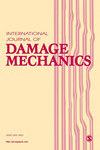混凝土的实验研究和微机械热疲劳模型
IF 3.9
2区 工程技术
Q2 MATERIALS SCIENCE, MULTIDISCIPLINARY
引用次数: 0
摘要
温度的巨大变化会对混凝土造成热疲劳破坏。在这项研究中,在温度为 10°C 至 80°C 的恒定相对湿度环境下,对三种不同类别(C20、C40 和 C60)的混凝土试样进行了热疲劳测试。通过超声波无损检测,确定了混凝土的弹性模量。热循环后,还记录了样品的质量减少和外观。结果表明,热疲劳的退化效应对混凝土有明显影响。随着热循环时间的延长,混凝土的弹性模量迅速降低,C60 混凝土比 C20 混凝土的弹性模量降低幅度更大。随着热循环的延长,损坏系数增加,超声波速度逐渐降低,这表明混凝土内部的微裂缝正在扩展。此外,还根据实验结果开发了微机械热疲劳模型。所提出的微机械损伤模型验证了在微尺度上模拟和描述热疲劳应力下混凝土物理行为的能力。本文章由计算机程序翻译,如有差异,请以英文原文为准。
Experimental investigations and micromechanical thermal fatigue models of concrete
The vast changes in temperature are what produce thermal fatigue damage to concrete. In this study, concrete specimens in three different categories—C20, C40, and C60—are tested for thermal fatigue at temperatures ranging from 10°C to 80°C in an atmosphere with constant relative humidity. Utilizing ultrasonic nondestructive testing, the elastic modulus of concrete is determined. After thermal cycling, the mass reduction and appearance of samples are also recorded. The results demonstrate that the degrading effects of thermal fatigue clearly influence concrete. As the thermal cycle lengthens, the elastic modulus of concrete rapidly decreases, and C60 concrete experiences a greater reduction in elastic modulus than C20 concrete. With thermal cycles, the damage factor increases and the ultrasonic wave velocity steadily decreases, suggesting a propagation of the concrete’s interior microcracks. Additionally, the micromechanical thermal fatigue model is developed based on the experimental results. The ability to simulate and describe the physical behavior of concrete under thermal fatigue stress on the microscale is validated by the proposed micromechanical damage model.
求助全文
通过发布文献求助,成功后即可免费获取论文全文。
去求助
来源期刊

International Journal of Damage Mechanics
工程技术-材料科学:综合
CiteScore
8.70
自引率
26.20%
发文量
48
审稿时长
5.4 months
期刊介绍:
Featuring original, peer-reviewed papers by leading specialists from around the world, the International Journal of Damage Mechanics covers new developments in the science and engineering of fracture and damage mechanics.
Devoted to the prompt publication of original papers reporting the results of experimental or theoretical work on any aspect of research in the mechanics of fracture and damage assessment, the journal provides an effective mechanism to disseminate information not only within the research community but also between the reseach laboratory and industrial design department.
The journal also promotes and contributes to development of the concept of damage mechanics. This journal is a member of the Committee on Publication Ethics (COPE).
 求助内容:
求助内容: 应助结果提醒方式:
应助结果提醒方式:


